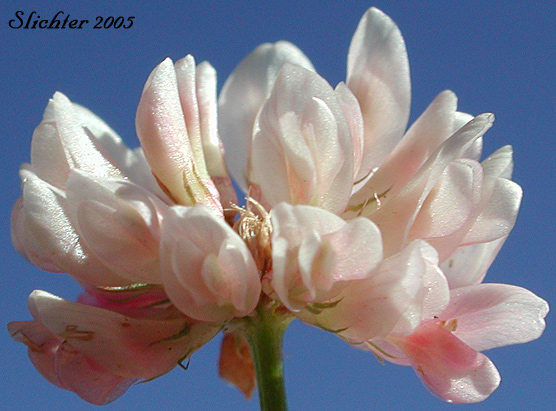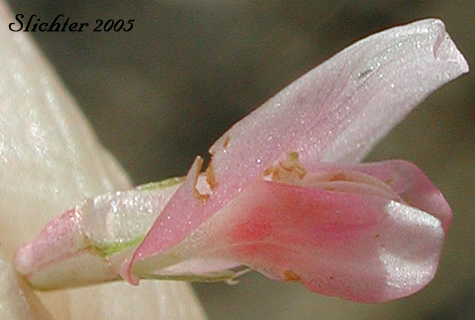
 The
photo at right shows a close-up of a flower of alsike clover. Note the pinkish
coloration to the corolla and long, slender calyx lobes (and glabrous calyx) as
well as the long, narrow wings which are slightly longer than the keel.
The
photo at right shows a close-up of a flower of alsike clover. Note the pinkish
coloration to the corolla and long, slender calyx lobes (and glabrous calyx) as
well as the long, narrow wings which are slightly longer than the keel.
Alsike clover is a largely glabrous perennial weed with several ascending to erect stems ascending 30-80 cm high from fibrous roots, or occasionally from a stolon. The stipules are 5-20 mm long, usually widest at the base and tapering gradually to a point. The leaves are alternately arranged along the stems and are ternately compound. The leaflets are ovate to obovate with rounded tips but they sometimes will have blunter tips or even a slight notch at the tip. The leaflets measure 1-5 cm long and are entire or may have minute, forward pointing teeth along the margins.
The flower heads are axillary and lack a subtending involucre. They measure 1.5-2.5 cm across and are nearly as long. The peduncles range from shorter than the leaves to several times their length. Individual flowers are white to reddish, are soon reflexed downwards, and measure about 5-9 mm long. The banner is nearly erect and longer than the wings and keel. The pedicels range from 1-5 mm long. The calyx is 1/3-1/2 as long as the corolla and is glabrous except for sparse tufts of hair in the notch between the calyx teeth. The calyx teeth are about equal in length to longer than the calyx tube.
Alsike Clover: Trifolium hybridum - The stipules are longer, the calyx often has tufts of hairs in the notch between the teeth, the flowers are a deeper pink color, and plants are less likely to creep.
White Clover: Trifolium repens - The stipules are shorter, the calyx is largely glabrous, lacking tufts of hairs in the notch between the calyx teeth, the flowers are whiter and plants are rhizomatous and more prone to creep.
A weedy species, alsike clover may be found on disturbed soils like roadsides, waste areas, fallow fields and gravel quarries.
A native of Europe, alsike clover may be found throughout much of the western United States.
In the Columbia River Gorge, it may be found between the elevations of 100'-1800' from west of Stevenson, WA eastward to the Major Creek Plateau.